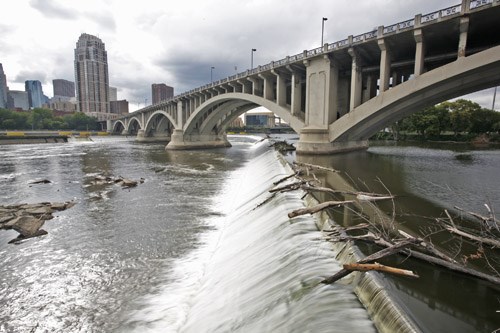
IntroductionLocated in the heart of the St. Anthony Falls and east bank milling district, this small park has great views of the falls. Interpretive panels describe the re-engineering of the falls from a natural cascade into one harnessed for industry. HistoryThe history of this area is largely about power: spiritual, physical, and political. Native American regarded the falls as having significant spiritual power. Logging interests floated logs south to the falls, where entrepreneurs built sawmills that tapped the power of the falling water to cut the logs into lumber. Other industrialists used the falls to power flour mills. Both logging and flour industries declined, but St. Anthony Falls still represented a significant source of power and in 1882 a commercial hydroelectric power station harnessed the power of the falls at this location. The advent of hydroelectric power profoundly changed the way local communities developed. Energy-dependent businesses once had to be on the river bank to gain access to the power of falling water using turbines or waterwheels. After the advent of hydroelectric power generation, businesses could tap the enormous power of the falls in the form of electric power transported through cables, allowing them to locate far away from the river. Hydroelectric power would have great effects on the region and spur a national discussion about rivers and their uses. A growing nation would wrestle with who would control river resources, who would benefit, and how competing claims would be accommodated. This vital discussion continues to this day. Water Power Park commemorates the nation’s first commercial hydroelectric generation station and how hydroelectric power changed the nation. The St. Anthony Falls Hydroelectric Project, completed in 1908, generates 14 megawatts of electricity. It was constructed near the first commercial hydroelectric generating station and is located within the St. Anthony Falls Historic District. The 1.4-acre park is owned and operated by Xcel Energy and was created as a condition of the federal relicensing of the St. Anthony Falls Hydroelectric Project. ActivitiesWater Power Park has foot trails, bike paths and benches. Visitors obtain great views of the river and dam that tamed St. Anthony Falls. Interpretative panels illustrate the area’s rich history. Hours, Directions, and Contact Information
Nearby SitesStone Arch Bridge, Father Hennepin Bluffs Park, Grand Rounds Scenic Byway, St. Anthony Falls Historic District, Nicollet Island, Boom Island Park, Mill City Museum, Mill Ruins Park |
Last updated: August 2, 2024
